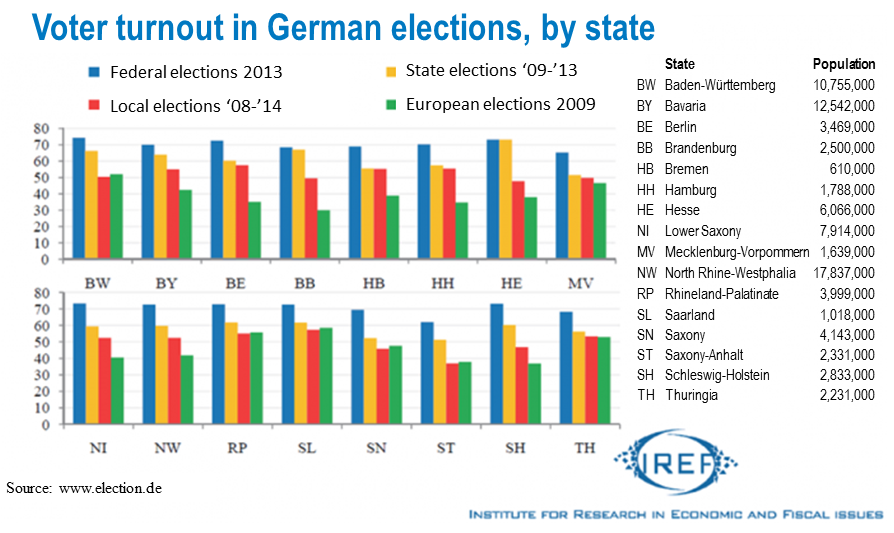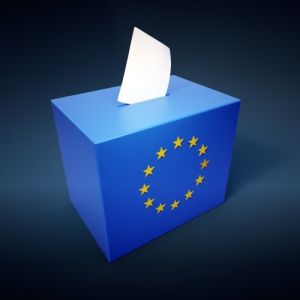“Nothing to see here, move on.” So goes the “apology” for low turnout rates in European elections as penned by many European analysts and commentators. “The US have them just as low at mid-term elections, so why worry?” Closer analysis of individual country data by the IREF, however, reveals that the “European turnout deficit” is actually worryingly high in many places, adding to existing concerns over EU’s democratic deficit.
When trying to account for lower turnout in European elections (EE), political scientists generally refer to “lower salience” of European parliamentary issues to the voter and a greater distance between voter’s decision and actual policy making, especially since many European policies do not primarily get made in the European parliament. Lower salience of issues voted on at lower levels of centralisation most likely lies also behind the latest IREF analysis of turnout rates in the four different kinds of elections held in Germany [German]. Germany’s economic policy-making including fiscal issues is relatively centralised [German] and therefore local elections matter less to a given tax-payer. So we find on the graph below that turnout rates in individual federal state elections are always lower than at national elections, with local elections turnout lower still. Even those, however, tower over turnout rates for EE in most states.

Only in five states can EE turnout compete with the low local election turnout: besides two former East German states also in – you guessed it – the three states around Strasbourg…
Lack of trust in the European Parliament has also been identified as one of the culprits of low EE turnout rates Europe-wide. Theoretically, of course, it could be that the overall European turnout is being dragged down by a few outlying countries with especially low turnout. But it turns out that EE turnout is determined in individual countries roughly by the same factors as the turnout for ordinary national elections: other things being equal it is higher when voting is compulsory (obviously), when the election is joined with another election or voting, and when it takes place on a weekend. It has been estimated that creating more than one constituency per country (at the moment only Belgium, UK, Ireland and France have multiple constituencies in EE) and moving the vote to a weekend would increase voter turnout by 10 percentage points. Would this be enough to cover the gap between the European and national election turnouts in individual countries?

No, it wouldn’t. As the graph above shows, what we can call a “European turnout deficit” remains more or less constant over time at around 20 percentage points on average. Many researchers have commented on the striking similarity between European election turnout rates and those in the US mid-term congressional elections where – so goes the apology – “things also matter less than in joined congress/presidential elections”, implying that the European deficit is not all that bad after all. Recent political science literature has, nevertheless, adopted a standard label for EE as a “second order election”.
European Turnout Deficit in Individual Countries
Claiming that the European turnout deficit is constant over time or that it mimics the US midterm election deficit glosses over important variations across individual countries. The European turnout deficit may be constant over time, but is certainly not constant over space. Using data from the European Parliamentary Research Service which has collated information on turnout rates from the latest national elections (2010-13) in individual countries, IREF has been has been able to calculate actual European turnout deficit in individual countries. Each European country has a different “standard” for customary turnout at national elections, ranging in percentage of the electorate from high 90s in countries where voting is compulsory (Belgium, Luxembourg) to less than a half in Lithuania, Poland, Hungary or Romania. (Not all compulsory voting countries achieve high turnouts – Greece mustered up only less than 63 percent at the last national election.) The following graph then shows what percentage of last national election’s turnout also voted in the last EE and therefore directly measures the individual country’s European turnout deficit. This is a much more relevant measure than the often used “(20) percentage points” measure: given the relatively low base turnout rates in many countries, even ten percentage points actually mean a substantial turnout deficit. (Our results are actually underestimating the true size of this deficit: national election turnouts are from years after the last EE, and if the secular downward trend in turnout rates is still continuing, the EE base turnout in an appropriately comparable later year would have been even lower.)

It is clear that there is nothing like a “European constant” that gets subtracted from whatever the nation’s customary domestic turnout tends to be; turnout deficits are different in different countries. In Belgium, perhaps unsurprisingly given that the only eligibility criteria to vote in Belgian EE is to be a European over 21 and, bizarrely, “to be able to speak French, Dutch or German” [French], the EE (compulsory) turnout rate in 2009 was actually 1 percentage point higher than in the 2010 national elections. Otherwise, in voluntary election countries, the European turnout deficit ranges from 10% in Latvia to 67% in Slovakia. In other words, two thirds of Slovaks who took part in the latest national election had not participated in the latest European election. Three additional countries (Czech Republic, Slovenia and the Netherlands) have European turnout rates less than a half of those in their national elections, with Poland scraping through at just above the magic line with 50.1%. Of the 8 most populous EU countries, 6 are among the bottom half of countries with the greatest European turnout deficit.
Who are these people that don’t go to elections? Precise data are naturally unavailable, but various survey estimates suggest that it is above all the young. Only about half as many 20-30 year olds vote as 60-70 year olds, in a pooled Europe-wide sample of the 2009 EE. Now, if this were a symptom particular to this current cohort of the young, there may be hope that as they grow older, the European turnout deficit will get plugged. Long-term data, however, suggest that the young have always voted less in EE than the old, and the current young turn out at a rate about 10 percentage points below that of their fathers when they were young [gated]. Therefore, as the current young grow older, as they displace the current old and are themselves displaced by an even less voting new young, EE participation is only set to decline further.
Health Warning: Organising European Elections May Harm Your Democratic Health
So far we have been taking (along with most political scientists) the national election turnouts as the base which, augmented by additional “second order election” factors causes the low EE turnout rates. We have already seen on the first graph that the high correlation between the two is remarkably constant over time. However, wherever a correlation exists, it is legitimate to ask whether the influence cannot actually run in the other direction. Could EEs, albeit younger than national elections, nevertheless decrease national voting? Naturally, the direction of causation is never easy to prove statistically, but with some careful analysis we can get close. Oxford University’s Sara Hobolt with her co-author have asked themselves whether “European Parliament elections have adverse consequences for democracy in Europe”. Using regression discontinuity model they find that EE actually lower turnout in national elections, “primarily due to the failure to mobilize new voters in these elections, with long-term effects on future electoral participation”. In other words, EE help to fix the young cohort in their lower-than-before low turnout rates which then travel with them throughout the voting population as they age. Every election, national or European, welcomes a certain number of fledglings who have matured since the last election. If you happen to be in a generation whose first eligible election is a European one, you will never become as active a voter as those who first participated in a national election. Your turnout will continue to be lower by 6 percent (p18)!
As a result, the low turnout is not just another symptom of some underlying trend of voter fatigue; it is actually a root of the problem. Voters’ attention is a scarce and precious commodity. If it is “wasted” on elections which have little impact on their everyday lives, or indeed on the taxes they face, that much less is left for elections which really decide fiscal matters. (Notice how happily Swiss voters vote a couple of times a year – because they are asked questions that actually matter.) The disease of EU’s democratic deficit may thus be spreading also to collective decision making at lower levels with much better chance of matching the common will of more homogenous local groups. As Hobolt and Franklin conclude in their paper, “European Parliament elections without genuine party competition regarding policy alternatives and a clear link between the rulers and the ruled that can facilitate public interest and engagement may thus have unintended negative consequences for democracy both in the European Union and at the national level.”






